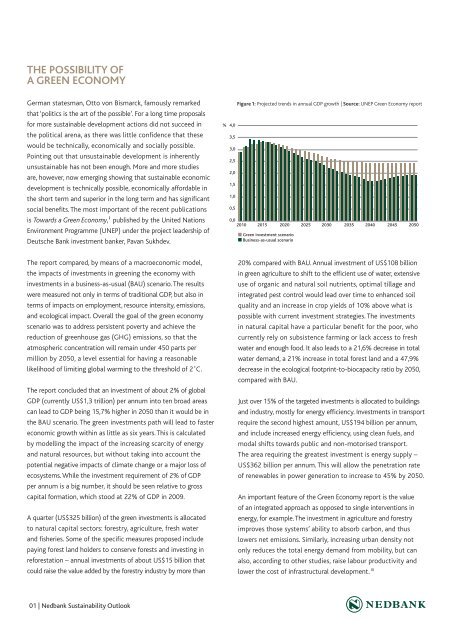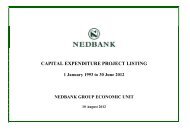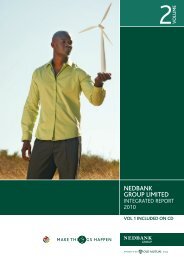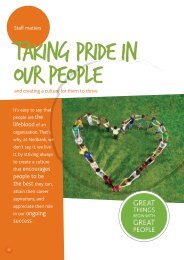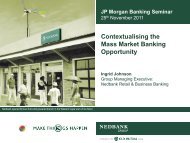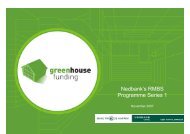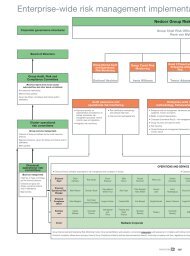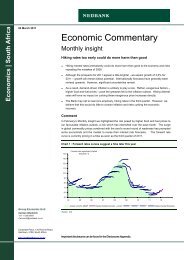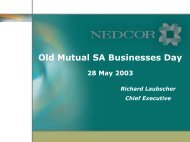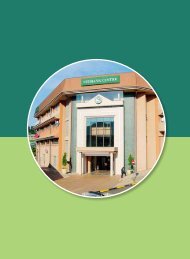To read more download PDF - Nedbank Group Limited
To read more download PDF - Nedbank Group Limited
To read more download PDF - Nedbank Group Limited
Create successful ePaper yourself
Turn your PDF publications into a flip-book with our unique Google optimized e-Paper software.
THE POSSIBILITY OF<br />
A GREEN ECONOMY<br />
German statesman, Otto von Bismarck, famously remarked<br />
that ‘politics is the art of the possible’. For a long time proposals<br />
for <strong>more</strong> sustainable development actions did not succeed in<br />
the political arena, as there was little confidence that these<br />
would be technically, economically and socially possible.<br />
Pointing out that unsustainable development is inherently<br />
unsustainable has not been enough. More and <strong>more</strong> studies<br />
are, however, now emerging showing that sustainable economic<br />
development is technically possible, economically affordable in<br />
the short term and superior in the long term and has significant<br />
social benefits. The most important of the recent publications<br />
is <strong>To</strong>wards a Green Economy, i published by the United Nations<br />
Environment Programme (UNEP) under the project leadership of<br />
Deutsche Bank investment banker, Pavan Sukhdev.<br />
% 4,0<br />
3,5<br />
3,0<br />
2,5<br />
2,0<br />
1,5<br />
1,0<br />
0,5<br />
Figure 1: Projected trends in annual GDP growth | Source: UNEP Green Economy report<br />
0,0<br />
2010<br />
2015 2020 2025 2030 2035 2040 2045 2050<br />
Green investment scenario<br />
Business-as-usual scenario<br />
The report compared, by means of a macroeconomic model,<br />
the impacts of investments in greening the economy with<br />
investments in a business-as-usual (BAU) scenario. The results<br />
were measured not only in terms of traditional GDP, but also in<br />
terms of impacts on employment, resource intensity, emissions,<br />
and ecological impact. Overall the goal of the green economy<br />
scenario was to address persistent poverty and achieve the<br />
reduction of greenhouse gas (GHG) emissions, so that the<br />
atmospheric concentration will remain under 450 parts per<br />
million by 2050, a level essential for having a reasonable<br />
likelihood of limiting global warming to the threshold of 2˚C.<br />
The report concluded that an investment of about 2% of global<br />
GDP (currently US$1,3 trillion) per annum into ten broad areas<br />
can lead to GDP being 15,7% higher in 2050 than it would be in<br />
the BAU scenario. The green investments path will lead to faster<br />
economic growth within as little as six years. This is calculated<br />
by modelling the impact of the increasing scarcity of energy<br />
and natural resources, but without taking into account the<br />
potential negative impacts of climate change or a major loss of<br />
ecosystems. While the investment requirement of 2% of GDP<br />
per annum is a big number, it should be seen relative to gross<br />
capital formation, which stood at 22% of GDP in 2009.<br />
A quarter (US$325 billion) of the green investments is allocated<br />
to natural capital sectors: forestry, agriculture, fresh water<br />
and fisheries. Some of the specific measures proposed include<br />
paying forest land holders to conserve forests and investing in<br />
reforestation – annual investments of about US$15 billion that<br />
could raise the value added by the forestry industry by <strong>more</strong> than<br />
20% compared with BAU. Annual investment of US$108 billion<br />
in green agriculture to shift to the efficient use of water, extensive<br />
use of organic and natural soil nutrients, optimal tillage and<br />
integrated pest control would lead over time to enhanced soil<br />
quality and an increase in crop yields of 10% above what is<br />
possible with current investment strategies. The investments<br />
in natural capital have a particular benefit for the poor, who<br />
currently rely on subsistence farming or lack access to fresh<br />
water and enough food. It also leads to a 21,6% decrease in total<br />
water demand, a 21% increase in total forest land and a 47,9%<br />
decrease in the ecological footprint-to-biocapacity ratio by 2050,<br />
compared with BAU.<br />
Just over 15% of the targeted investments is allocated to buildings<br />
and industry, mostly for energy efficiency. Investments in transport<br />
require the second highest amount, US$194 billion per annum,<br />
and include increased energy efficiency, using clean fuels, and<br />
modal shifts towards public and non-motorised transport.<br />
The area requiring the greatest investment is energy supply –<br />
US$362 billion per annum. This will allow the penetration rate<br />
of renewables in power generation to increase to 45% by 2050.<br />
An important feature of the Green Economy report is the value<br />
of an integrated approach as opposed to single interventions in<br />
energy, for example. The investment in agriculture and forestry<br />
improves those systems’ ability to absorb carbon, and thus<br />
lowers net emissions. Similarly, increasing urban density not<br />
only reduces the total energy demand from mobility, but can<br />
also, according to other studies, raise labour productivity and<br />
lower the cost of infrastructural development. i i<br />
01 | <strong>Nedbank</strong> Sustainability Outlook


